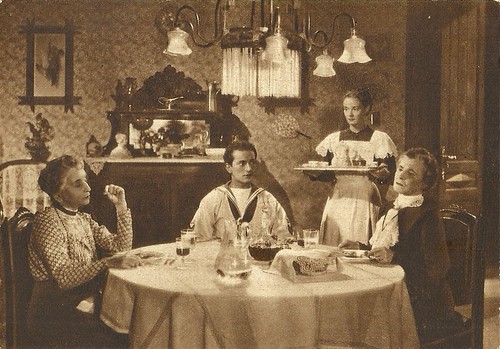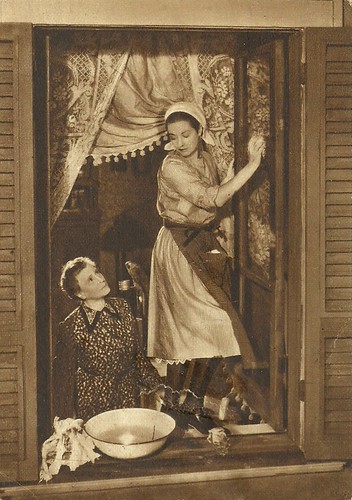Irma Gramatica (1867-1962) was an Italian stage and screen actress, known for her qualities but also for her temper. Gramatica appeared in ten films during her career. She was the sister of actress Emma Gramatica.
![Irma Gramatica]()
Italian postcard, no. 48. Photo: Sciutto, Genoa.
Irma Gramatica was born as Maria Francesca Gramatica in 1867 in Fiume, Italy, now Rijeka, Croatia. She was the daughter of Domenico Gramatica and the Hungarian Cristina Bradil, respectively a prompter and a seamstress in the company of Luigi Monti.
She had two sisters, both actresses as well: Emma Gramatica and Anna Capodaglio. Though born Maria Francesca, she was called Irma from her childhood. In Carnia, Friuli, where she was raised, all Mariafrancesca’s were called Irma.
Already at the age of five years she debuted on stage in the drama Cause ed effetti by Paolo Ferrari and she immediately showed enormous potential. In her girlhood she starred alongside the great players of the time. She suported Cesare Rossi, Jacinta Pezzana, Flavio Andò and Eleonora Duse in the play Fedora by Victorien Sardou. She also joined them in a major tour through South America.
There the first symptoms of imbalance began to appear. Irma tried to commit suicide by eating exotic fruit contaminated by yellow fever. The reason is unknown but seems linked to difficulties related to a great inner pain, not to sentimental origins.
At seventeen she married the actor Arnaldo Cottin and they had a son the following year. With Cottin she returned to Argentina two years later. During the tour, their child, left back in Italy, died. The incident led to the separation of Gramatica and her husband.
While remaining in Argentina, Irma contracted meningitis from which she was saved, but anemic and weakened by an intense nervous breakdown she suffered a deep depression, beginning to perceive her existence as an unbearable burden.
![Irma Gramatica]()
Italian postcard, no. 512. Photo: Sciutto, Genoa.
After her return to Italy in 1892, Irma Gramatica became 'First Young Actress' in the company of Italia Vitaliani and Vittorio Salsilli in 1892. In 1895, she became 'primattrice' (First Actress), under the guidance of Napoleone Mozzidolfi and directed by Alessandro Marchetti. Under the guidance of V. Valli she perfected her outstanding temperament, suitable for a very wide repertoire.
Irma proved to be sensitive both to the new theatre as well as the romantic authors of the 19th century. After leaving Eleonora Duse’s company, Irma entered that of Ermete Zacconi, an actor about whom Irama said that he "had absolute influence on the conduct of my artistic faculties."
From here began her great successes that led to the birth of the famous stage company Talli-Gramatica-Calabresi. Irma was the first Nennele in Come le foglie by Giuseppe Giacosa, Lisa in Dal tuo al mio by Giovanni Verga, and Paolina in Sperduti nel buio by Roberto Bracco.
A highlight was her role as Mila di Codro in La figlia di Jorio. Gabriele D'Annunzio had written this play especially for Eleonora Duse but because of illness, Duse could not perform the part on stage.
![Irma Gramatica]()
Italian postcard by TCR, no. 2. Photo: Varischi & Artico Co., Milano.
![Irma Gramatica]()
Italian postcard by T.C.R., no. 1. Photo: Varischi & Artico Co., Milano.
Irma Gramatica had a grumpy and irritable character. She called it herself a 'severe nature'. Irma always tried to be approached as little as possible, and admitted that she detested interviews. She fely a real phobia for them and almost always rejected them.
In the late 1930s and early 1940s she was active as film actress at the new Cinecittà studios. Sometimes she paired with her sister Emma as in Sissignora/Yes, madam (Fernando Maria Poggioli, 1941), starring María Denis, and in the comedy Sorelle Materassi/The Materassi Sisters (Fernando Maria Poggioli, 1944).
Among her young co-stars in those years were Laura Adani, Clara Calamai, Maria Mercader and German actress Anneliese Uhlig.
Irma also played the widow Pescatore in the Italian version of Il fu Mattia Pascal/The Former Mattia Pascal (Pierre Chenal, 1937), starring Pierre Blanchar. The film is based on the 1904 novel The Late Mattia Pascal by Luigi Pirandello.
Immediately after the war she had an important part in the refugees film Lo sconosciuto di San Marino/Unknown Men of San Marino (Michał Waszyński, 1946), starring Anna Magnani, and for which Cesare Zavattini had written the script.
Her last part was in Incantesimo tragico/Tragic Spell (Mario Sequi 1951), a period drama about a cursed treasure, set in the Maremma region. Her co-stars were María Félix, Rossano Brazzi, Massimo Serato and Charles Vanel.
Irma Grammatica died in Villa Giuseppina at Tavarnuzze in 1962. She was 91.
![Sissignora]()
Italian postcard. Photo: Irma and Emma Grammatica, María Denis and Leonardo Cortese in Sissignora/Yes, Madam (Ferdinando Maria Poggioli, 1941).
![Maria Denis in Sissignora]()
Italian postcard. Photo: Irma or Emma Grammatica and María Denis in Sissignora/Yes, Madam (Ferdinando Maria Poggioli, 1941).
New Monday a post on Irma's sister Emma Gramatica.
Sources: Wikipedia (Italian and English) and IMDb.

Italian postcard, no. 48. Photo: Sciutto, Genoa.
Enormous potential
Irma Gramatica was born as Maria Francesca Gramatica in 1867 in Fiume, Italy, now Rijeka, Croatia. She was the daughter of Domenico Gramatica and the Hungarian Cristina Bradil, respectively a prompter and a seamstress in the company of Luigi Monti.
She had two sisters, both actresses as well: Emma Gramatica and Anna Capodaglio. Though born Maria Francesca, she was called Irma from her childhood. In Carnia, Friuli, where she was raised, all Mariafrancesca’s were called Irma.
Already at the age of five years she debuted on stage in the drama Cause ed effetti by Paolo Ferrari and she immediately showed enormous potential. In her girlhood she starred alongside the great players of the time. She suported Cesare Rossi, Jacinta Pezzana, Flavio Andò and Eleonora Duse in the play Fedora by Victorien Sardou. She also joined them in a major tour through South America.
There the first symptoms of imbalance began to appear. Irma tried to commit suicide by eating exotic fruit contaminated by yellow fever. The reason is unknown but seems linked to difficulties related to a great inner pain, not to sentimental origins.
At seventeen she married the actor Arnaldo Cottin and they had a son the following year. With Cottin she returned to Argentina two years later. During the tour, their child, left back in Italy, died. The incident led to the separation of Gramatica and her husband.
While remaining in Argentina, Irma contracted meningitis from which she was saved, but anemic and weakened by an intense nervous breakdown she suffered a deep depression, beginning to perceive her existence as an unbearable burden.

Italian postcard, no. 512. Photo: Sciutto, Genoa.
Outstanding temperament
After her return to Italy in 1892, Irma Gramatica became 'First Young Actress' in the company of Italia Vitaliani and Vittorio Salsilli in 1892. In 1895, she became 'primattrice' (First Actress), under the guidance of Napoleone Mozzidolfi and directed by Alessandro Marchetti. Under the guidance of V. Valli she perfected her outstanding temperament, suitable for a very wide repertoire.
Irma proved to be sensitive both to the new theatre as well as the romantic authors of the 19th century. After leaving Eleonora Duse’s company, Irma entered that of Ermete Zacconi, an actor about whom Irama said that he "had absolute influence on the conduct of my artistic faculties."
From here began her great successes that led to the birth of the famous stage company Talli-Gramatica-Calabresi. Irma was the first Nennele in Come le foglie by Giuseppe Giacosa, Lisa in Dal tuo al mio by Giovanni Verga, and Paolina in Sperduti nel buio by Roberto Bracco.
A highlight was her role as Mila di Codro in La figlia di Jorio. Gabriele D'Annunzio had written this play especially for Eleonora Duse but because of illness, Duse could not perform the part on stage.

Italian postcard by TCR, no. 2. Photo: Varischi & Artico Co., Milano.

Italian postcard by T.C.R., no. 1. Photo: Varischi & Artico Co., Milano.
A severe nature
Irma Gramatica had a grumpy and irritable character. She called it herself a 'severe nature'. Irma always tried to be approached as little as possible, and admitted that she detested interviews. She fely a real phobia for them and almost always rejected them.
In the late 1930s and early 1940s she was active as film actress at the new Cinecittà studios. Sometimes she paired with her sister Emma as in Sissignora/Yes, madam (Fernando Maria Poggioli, 1941), starring María Denis, and in the comedy Sorelle Materassi/The Materassi Sisters (Fernando Maria Poggioli, 1944).
Among her young co-stars in those years were Laura Adani, Clara Calamai, Maria Mercader and German actress Anneliese Uhlig.
Irma also played the widow Pescatore in the Italian version of Il fu Mattia Pascal/The Former Mattia Pascal (Pierre Chenal, 1937), starring Pierre Blanchar. The film is based on the 1904 novel The Late Mattia Pascal by Luigi Pirandello.
Immediately after the war she had an important part in the refugees film Lo sconosciuto di San Marino/Unknown Men of San Marino (Michał Waszyński, 1946), starring Anna Magnani, and for which Cesare Zavattini had written the script.
Her last part was in Incantesimo tragico/Tragic Spell (Mario Sequi 1951), a period drama about a cursed treasure, set in the Maremma region. Her co-stars were María Félix, Rossano Brazzi, Massimo Serato and Charles Vanel.
Irma Grammatica died in Villa Giuseppina at Tavarnuzze in 1962. She was 91.

Italian postcard. Photo: Irma and Emma Grammatica, María Denis and Leonardo Cortese in Sissignora/Yes, Madam (Ferdinando Maria Poggioli, 1941).

Italian postcard. Photo: Irma or Emma Grammatica and María Denis in Sissignora/Yes, Madam (Ferdinando Maria Poggioli, 1941).
New Monday a post on Irma's sister Emma Gramatica.
Sources: Wikipedia (Italian and English) and IMDb.